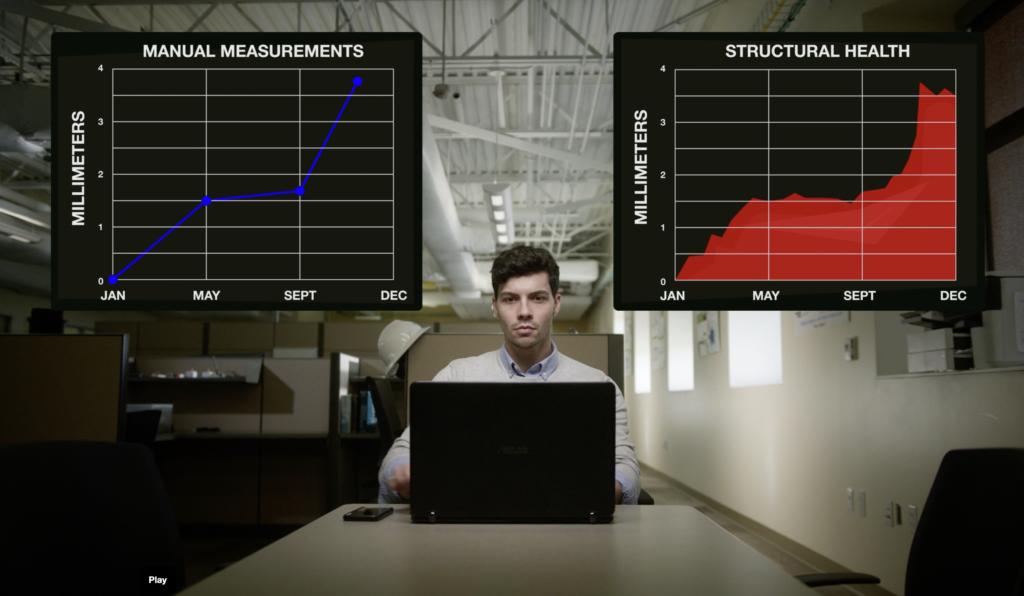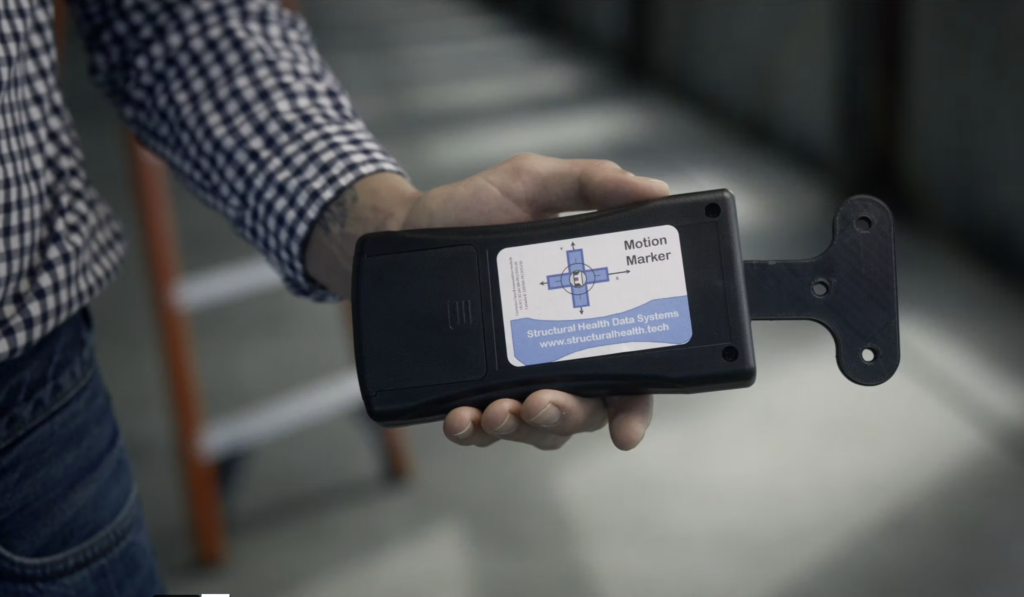- (254) 733-6954
- info@structuralhealth.tech
- PO Box 81, McGregor, Texas 76657
BETTER DATA
BETTER DECISIONS
Our Devices Measure and Track Structure Cracks
Decision quality data
Structural Health Data Systems provides Movement Monitors (MMs) that electronically record building / foundation crack changes hourly.
Users receive a Rich Data Stream to assess current performance, evaluate
quality of recent repairs, and determine whether future action is warranted.
Movement Monitors measure critical characteristics of distressed or at-risk structures. The most important aspect of our products is that they record data around the clock (24/7/365) autonomously without anyone having to think about it.
The data is taken with time reference and stored by our company where it can be managed, analyzed, and correlated with other readings to determine causative factors. Because of the hourly recording of multiple conditions and reactions within a structure, a much clearer picture is available to isolate issues, design problem remedies, and in many cases, minimize expensive repairs.

What's Needed
The key to making good decisions regarding building cracks is DATA — Accurate, sufficiently detailed, reliable DATA.
Until recently, the only way to see detailed, up-to-the-moment movement data has been through sophisticated and costly monitoring equipment normally operated by specialty companies.
Alternatively, low-tech manual gauges require a field technician or often an engineer to conduct time consuming and costly site visits that yield sporadic data and no information about movement behavior between readings.
What’s needed — a monitoring device that combines automated precision measurement, web-based data access, and analytical tools for easy, everyday use at a reasonable cost.
The Solution
The SHDS Movement Monitor
The solution — Structural Health Data System’s revolutionary Movement Monitor.
An automated, web-enabled, remotely accessed monitor.
Once installed, our patented device measures and transmits crack movement formation hourly to a cloud- accessed database system. Measurements are taken hourly with better than 0.01 inch increments in two dimensions (vertical and horizontal), along with temperature measurements.
RICH DATA: From web-accessible devices, hundreds of relevant, accurate data points are immediately reduced to highlight critical issues. What took hours can be done in minutes with improved accuracy.

Our PROVEN DIFFERENCE
The Movement Monitor (MM) has been deployed successfully in widely varying situations, providing a significant upgrade in quantity and quality of real-time data available at any time.
BETTER RELIABILITY
The MM reliably tracks hourly movement, creating a seamless picture of crack performance through seasons, weather events, and across multiple years if desired. Users can remotely monitor and retrieve device status, establish notification parameters, and can quickly know if there is an issue without site-visits.
MORE ACCURACY
SHDS’ MM measures in 0.2mm increments (about 0.01 inches), which is more ACCURATE than common plastic gages that measure to the nearest 1 mm (about 0.04 inches).
COST FRIENDLY
The Cost of employing the Movement Monitor (MM) compares favorably and is often less than traditional plastic manual gages when considering trip costs and data-reduction time required with plastic gages.
Peace of Mind in Your Infrastructure
The MM value and benefit are quickly evident from the first hour results begin flowing. Wherever a crack becomes a concern, the information and data to understand whether action is necessary or not IS IMPORTANT.
The busy schedules and demanding responsibilities of an active Engineering practice leave little flexibility for frequent surveillance trips or missing a data reading.
Our MM system doesn’t just capture hourly readings, but can also send alerts when set parameters are reached, allowing users to confidently focus on other work.

FREQUENTLY ASKED QUESTIONS
When installed properly and with reasonable care, this system has reported reliably for over 5 years (70,000 hourly reports). The device signal reception to the transceiver and WIFI connectivity require the most attention in setup, but when these are established correctly up front, the system is remarkably stable and dependable.
Just as with manual gauges, attention must be paid to alignment and setting. However, after installing a couple of devices and becoming familiar with the template, our Movement Marker is essentially as easy or easier to set than a manual gauger.
After a device is installed, it can be turned, reset, and checked on the web with ease. The reset essentially zeros the device to start reading from an origin which is very handy
Depending on walls and structure layout, devices can be installed as much as 300 ft from a receiver. However, with significant or numerous interfering structures, that can be reduced to around 100 ft.
Rainfall and temperature tables can be downloaded for thousands of sites usually within 3-4 miles of a site and these are easily translatable to chart software that can correlate the impacts of temperature and precipitation on facility movement.
When you input your email address during setup, that address receives email notices for receiver out of service or for specified movement parameters.
Access to our database follows “ “ protocols and is not accessible from anyone without credentials. Each client is given their own account and control to manage their Who has access? After establishing your password, only our security manager and those with whom you share access to your username password combination can access you’re data.
Our databases are backed up daily on two independent systems and are readily restored without risk of loss to saved data.
Yes, currently with 2 devices, but on board 3 dimension
measurement is planned.
Yes, see question 21.
We have employed devices successfully in temperatures ranging from 0 F to over 150 F (as read on the device). If a device is deployed in high heat, direct sun, we recommend providing some sort of radiant barrier shading to minimize internal component damage over long duration solar exposure.
Occasional missed measurements are rare but do happen. Radio signal garble, WIFI connectivity, Power outages, and other abnormalities will interrupt transmissions from time to time. For this occasional miss and the rare system malfunction, we have installed a Catch-up process that stores 4 days of readings on board the measuring device itself. Once daily, measurements for the previous 96 hours are transmitted to the database, whether needed or not. So there are normally 4opportunities for missed transmissions to be placed into the database. After 96 hours, the readings are overwritten.
If no readings are received after about 24 hours, SHDS recommends checking for possible causes, and monitoring for a successful catchup transmission.
CUPs are sent roughly every 24 th transmission, so about every 24 hours. To see when CUPs were last sent on the USER platform, click on Query 7, List Transmissions for a Device.
That data cannot be recovered. The device and transceiver must be physically checked for issues.
If data is not being received by multiple devices using the same transceiver, the transceiver and/or WIFI connection need to be checked. Unplugged or damaged equipment is usually at issue. Assuming the Transceiver is working (confirmed by seeing transmissions from other MMs that use the same Transceiver), causes may be the following:
a. A physical incident has rendered the MM inoperable.
b. Water or other substance has damaged the MM.
c. The distance from the Transceiver, or the obstacles between the MM and the Transceiver,
cause an intermittent connection. One remedy is to reduce the distance or number of obstacles between the MM and the Transceiver.
An MM may use different Transceivers if others are on-site and in-range. Some reasons a Transceiver may not work include the following:
a. A physical incident has rendered the Transceiver inoperable.
b. Water or other substance has damaged the Transceiver.
c. The internet is down.
d. The Transceiver is not receiving power.
e. The internet is no longer connected to the Transceiver.
Some cell phones don’t easily connect to the devices for provisioning. A laptop should work, as might a different cell phone.
Please check to confirm that the Wi-Fi service is 2.5 Ghz frequency. The system is not compatible with a different frequency.
Sure, although the User should update the system information so that graphs and other reports will clearly differentiate between the old and new location. We recommend that the MM be turned off at the old location, and back on at the new, so that there will be a clear indication in reports of a possible relocation. Please contact SHDS for assistance.
We suggest resetting the device, per the information in question 8. The User needs to make sure that using information from movement reports and device performance reports clearly understand when the device was re-set, and adjust the offset appropriately.
We have routinely operated devices below 2.5 V (usually over 4 years); however, we suggest replacing the battery when the voltage is less than about 2.75 volts.


